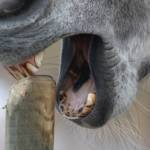Honey for Wound Healing in Horses

Did you know that medical-grade honey can help heal wounds?
“This sweet feature of honey may come in handy for horses, which are known for complications associated with wound repair and healing,” noted Laura Petroski-Rose, B.V.M.S., a Kentucky Equine Research veterinarian.
No matter how well a wound was sutured, complications occur in up to 75% of cases, especially for injuries of the lower limb. Causes of repair failure include infection and lack of extra tissue available to suture the wound closed without tension.
“Medical-grade honey reportedly has broad antibacterial activity and appears effective against drug-resistant strains such as Staphylococcus aureus, also called MRSA,” Petroski-Rose said. “Honey also has anti-inflammatory effects and can provide wounds with nutrients to facilitate healing. Honey may also expedite healing.”
One recent study* confirmed the benefits of honey on wound healing after honey was placed inside the wound during repair rather than simply applying it topically afterwards. The researchers found:
- Medical-grade honey placed inside wounds at the time of repair did not result in any adverse effects;
- Significantly improved healing was noted in horses treated with medical-grade honey; and
- Significantly fewer infections occurred in honey-treated horses.
“Only medical-grade honey should be applied to horse wounds, not just honey off the grocery store shelf or raw honey from your local apiary. Raw honey may contain bacterial spores that can cause botulism or gangrene,” Petroski-Rose warned.
Nutritional supplements that target skin health and boost anti-inflammatory properties can be beneficial for horses with wounds. Check out the following articles for more information:
- Managing Horse Wounds? Include Biotin
- Nano-E Aids Wound Healing in Horses: Customer Report
- Skin Funk in Horses: Omega-3s to the Rescue
*Mandel, H.H., G.A. Sutton, E. Abu, et al. Intra-lesional application of medical grade honey improves healing of surgically treated lacerations in horses. Equine Veterinary Journal. In press.








